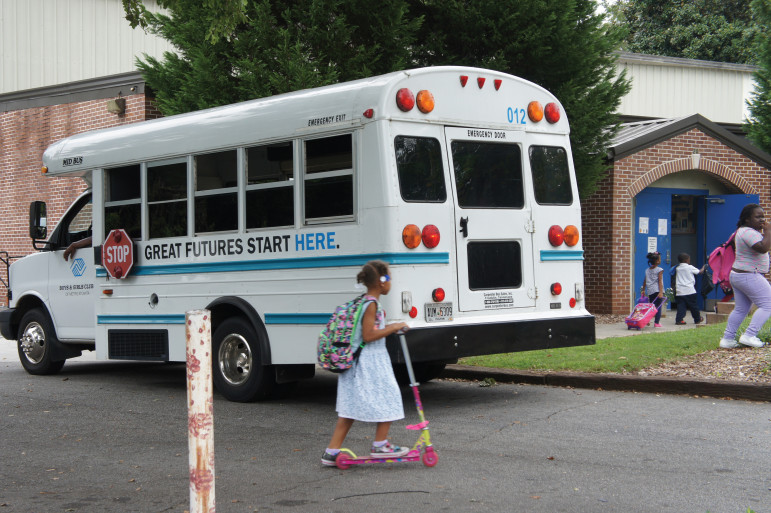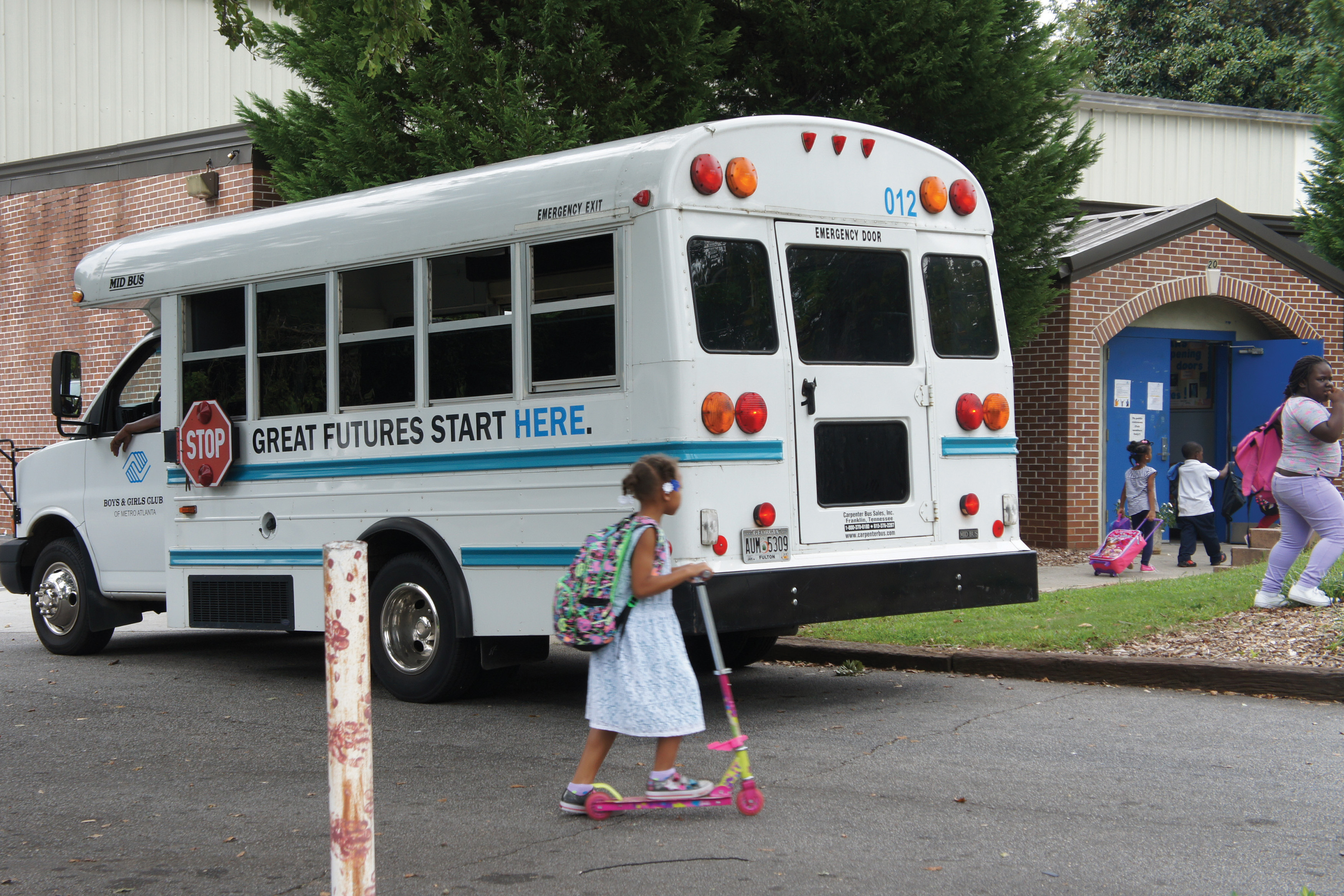
Stell Simonton
A Boys & Girls Club van drops off children at the George Washington Carver Boys & Girls Club in Atlanta. Youth organizations should make sure they don’t have holes in their insurance coverage.
Don’t miss additional resources at the bottom of this story.
The staff of the Boys & Girls Club of Bay County, Fla., was overjoyed when the organization received a donated trolley bus from the county transportation organization. The club, which picks up kids from 10 area schools, has two full-size buses and two vans, but it wanted to serve additional schools.
The trolley will get a full safety check-up from both the county and the club before it’s put on the road, said Executive Director Paul Mosca. It will, of course, also be insured under the club’s liability insurance policy.
Having the right insurance is key for nonprofit organizations, not only to manage risks but also because some business contracts, such as rental agreements or grants, insist on certain coverage. And the right coverage policies can be expensive. The Boys & Girls Club of Bay County pays more than $30,000 per year for liability insurance.
While Mosca can turn to the national Boys & Girls Club of America — which has more than 4,100 club facilities around the country and 2 million registered members — local affiliates make their own purchasing decisions, said Mosca. Like Mosca, all youth organization leaders must decide how to best insure their organizations and manage risks.
Pamela Davis, president and chief executive of the Nonprofits Insurance Alliance Group, based in Santa Cruz, Calif., said the coverage nonprofits choose often isn’t appropriate for their needs. “Business owners’ policies, which limit coverage to just the four walls of an office, are inappropriate for 99 percent of nonprofits,” said Davis.
She listed specific types of insurance and safety practices that are important for nonprofits to consider — from auto to Directors & Officers and more.
‘Dirty secret’ of auto insurance
In addition to buying insurance for vehicles owned by the nonprofit, an organization must make sure its drivers are properly licensed and insured.
Nonprofit leaders should verify that employees and volunteers have private auto insurance if they drive their own cars on behalf of the nonprofit, Davis said, and should check driving history if they are driving young people.
Nonprofits should also buy additional coverage called “non-owned/hired” insurance, Davis said.
Elizabeth Wightman, chief operating officer of SteelBridge Insurance Services in Santa Cruz, Calif., called the need for this type of insurance the dirty secret of auto insurance for nonprofits in her blog on the SteelBridge website.
Wightman points out that volunteers and employees often drive their own vehicles while doing business for the nonprofit; for example, a volunteer treasurer may drive to meet with a large donor, or a program director may drive to give a class at a local school.
“Non-owned/hired” insurance serves to protect the nonprofit if an employee or volunteer driving her own car on behalf of the nonprofit has an accident that causes damage higher than the individual’s own auto insurance, Davis explained.
Slips and falls
Around 90 percent of insurance claims made by nonprofits are either auto-related or stem from accidents and injuries at the organization’s property or event, according to Davis.
General liability insurance, also known as “slip-and-fall” coverage, protects the organization when it is held liable because its actions are alleged to have injured someone or caused property to be damaged, Davis said.
Most accidents are minor, said Andy Morse, senior agent with Nonprofit Insurance Advisors, a service of the Minnesota Council of Nonprofits. For example, someone attending an event held by a Minnesota nonprofit sprained an ankle, he said. The emergency room visit cost $8,000. In another instance, someone bit down on a nut and broke a tooth. The organization’s insurance covered both incidents.
Improper sexual conduct
Ten percent of claims reported by nonprofits stem from allegations of improper employment practices, professional errors/omissions and sexual abuse, Davis said. Payouts from these claims tend to be higher than those from accidents and injuries. Together they account for one-fourth of the money paid out in claims, she said.
Any organization that works with young people must think about the risk of sexual abuse. Potential abusers could be employees, volunteers or even young clients, Davis said. Improper sexual conduct insurance protects a nonprofit against these allegations. Policies should be checked to make sure they cover abuse committed by clients, too, she said.
Directors & Officers coverage
When provided to nonprofits, this type of insurance typically covers both employment practices and mismanagement, including allegations of harassment, discrimination (on the basis of disability) and wrongful termination. However, it is important to check the particular insurance policy, as all D&O policies are slightly different, Davis said, encouraging nonprofits to make sure a D&O policy covers employees, volunteers and current and past directors.
Professional errors
An organization’s leader may think their general liability insurance is enough to cover employees from “errors and omissions” when directly caring for kids. However, nonprofits in the business of caring for children in any sort of professional capacity — and that are responsible for the well-being of those children — should also have social services professional insurance, Davis said. While organizations pay for the agency’s insurance, which names the professionals as additional insureds, some professions such as medical professionals and social workers, need to provide their own coverage as well for licensure.
Resources: Learn the basics of insurance for nonprofit youth agencies.
- Check your state nonprofit association, if one exists, for insurance brokerage services. Thirty-six states have nonprofit associations affiliated with the National Council of Nonprofits, and other state nonprofit associations exist. The Minnesota Council of Nonprofits, for example, has its own insurance agency.
- Nonprofits Insurance Alliance Group is a nonprofit that provides a wealth of insurance information and brokerage services.
- “A Board Members Guide to Nonprofit Insurance,” by Pamela Davis, president and CEO of Alliance for Nonprofit Insurance, Risk Retention Group (ANI-RRG).
Keeping your nonprofit in business: Resources for more information and organizational development
- American Nonprofits is a membership organization open to U.S. nonprofits and their staff, stakeholders and volunteers.
- American Nonprofits publishes Blue Avocado. This online magazine for nonprofits has published articles on every aspect of nonprofit management — from audits to volunteerism, and everything in between.
- BoardSource is a 25-year-old nonprofit dedicated to all things related to nonprofit board governance. With free online resources and additional tools for members, BoardSource offers training, publications, online tools, consultation and more.
- Charities Review Council serves donors and nonprofits, offering education and technical assistance, including an assessment tool for nonprofits.
- GuideStar, itself a nonprofit, aims to revolutionize philanthropy by providing information that advances transparency, enables users to make better decisions and encourages charitable giving.
- National Council of Nonprofits, an association that helps small and mid-size nonprofits lead effectively, has 36 state associations.
- Many states have centers or associations of nonprofits aimed at helping such charities succeed. Check your state’s association for guidance. Examples are the Georgia Center for Nonprofits and the New York Council of Nonprofits.
- Nonprofit Risk Management Center provides information, online tools, training and consulting to nonprofits on managing risk. Its publications include the e-book “The Season of Hope: A Risk Management Guide for Youth-Serving Nonprofits,” published in 2002.
- Register to fund raise: In 39 states, charitable nonprofits must register with the state before fund raising. In most cases, it’s the secretary of state’s office, but in a few the jurisdictional agency is called something else. Check the National Council of Nonprofits’ web site for state-by-state information.


























